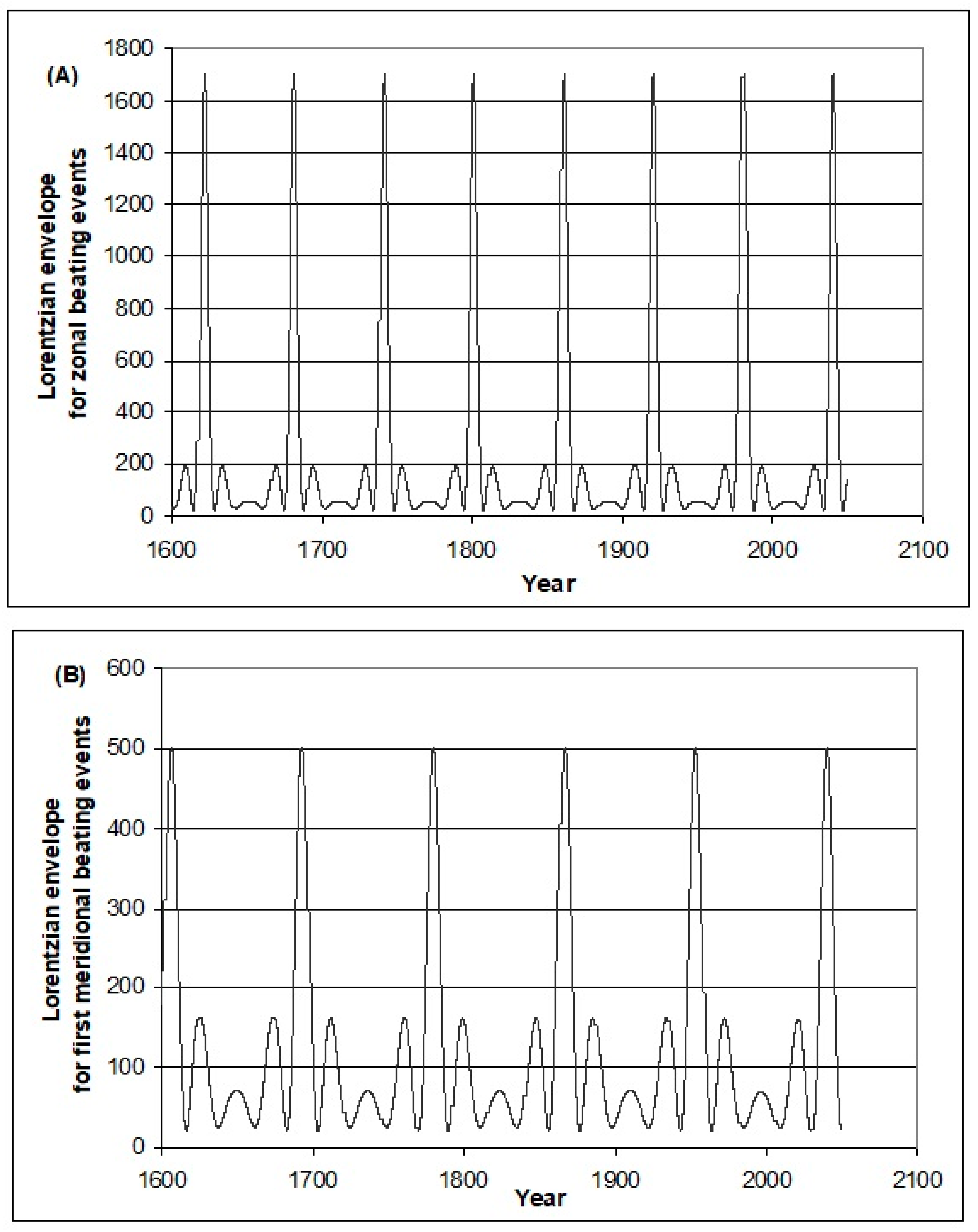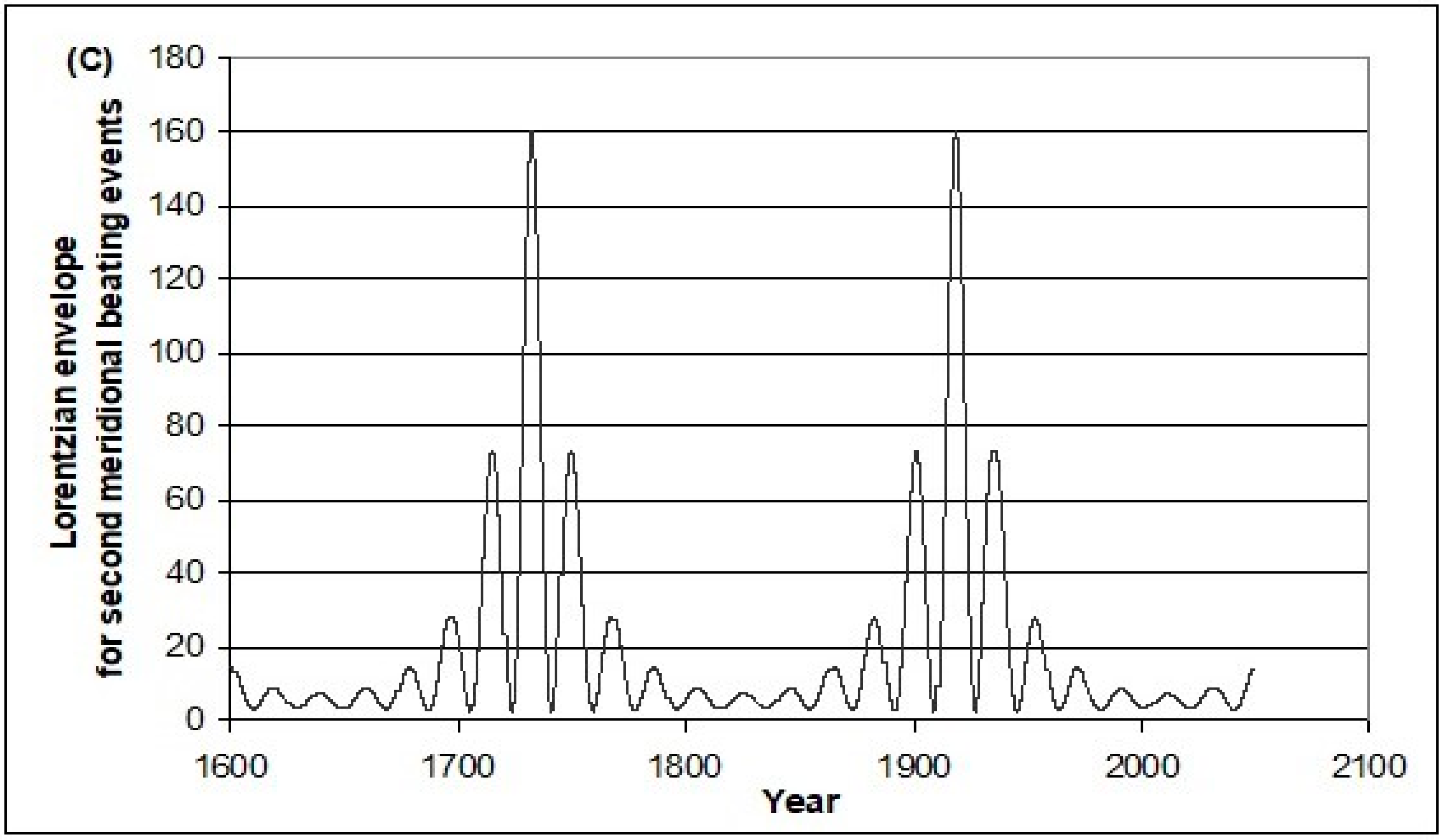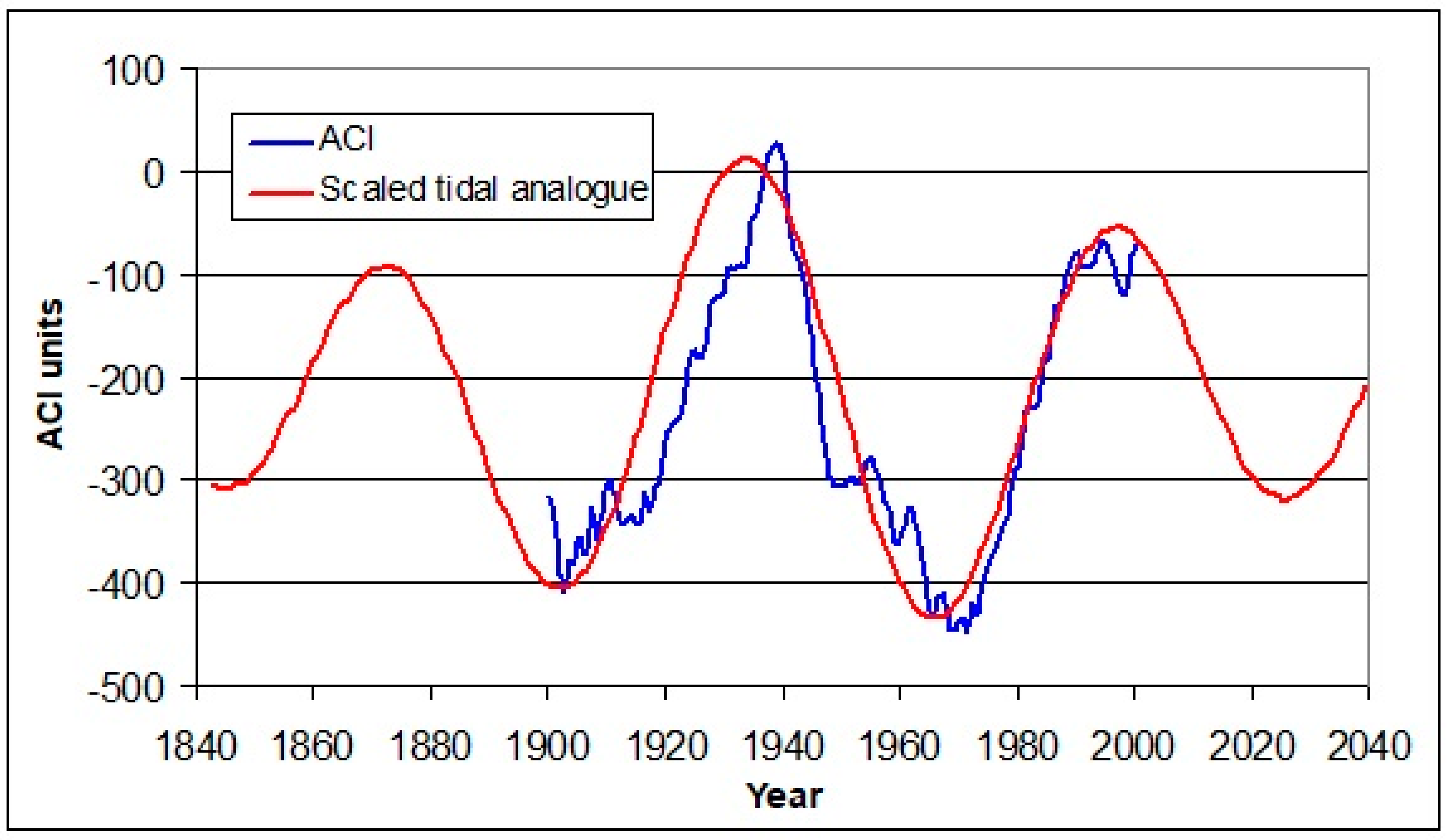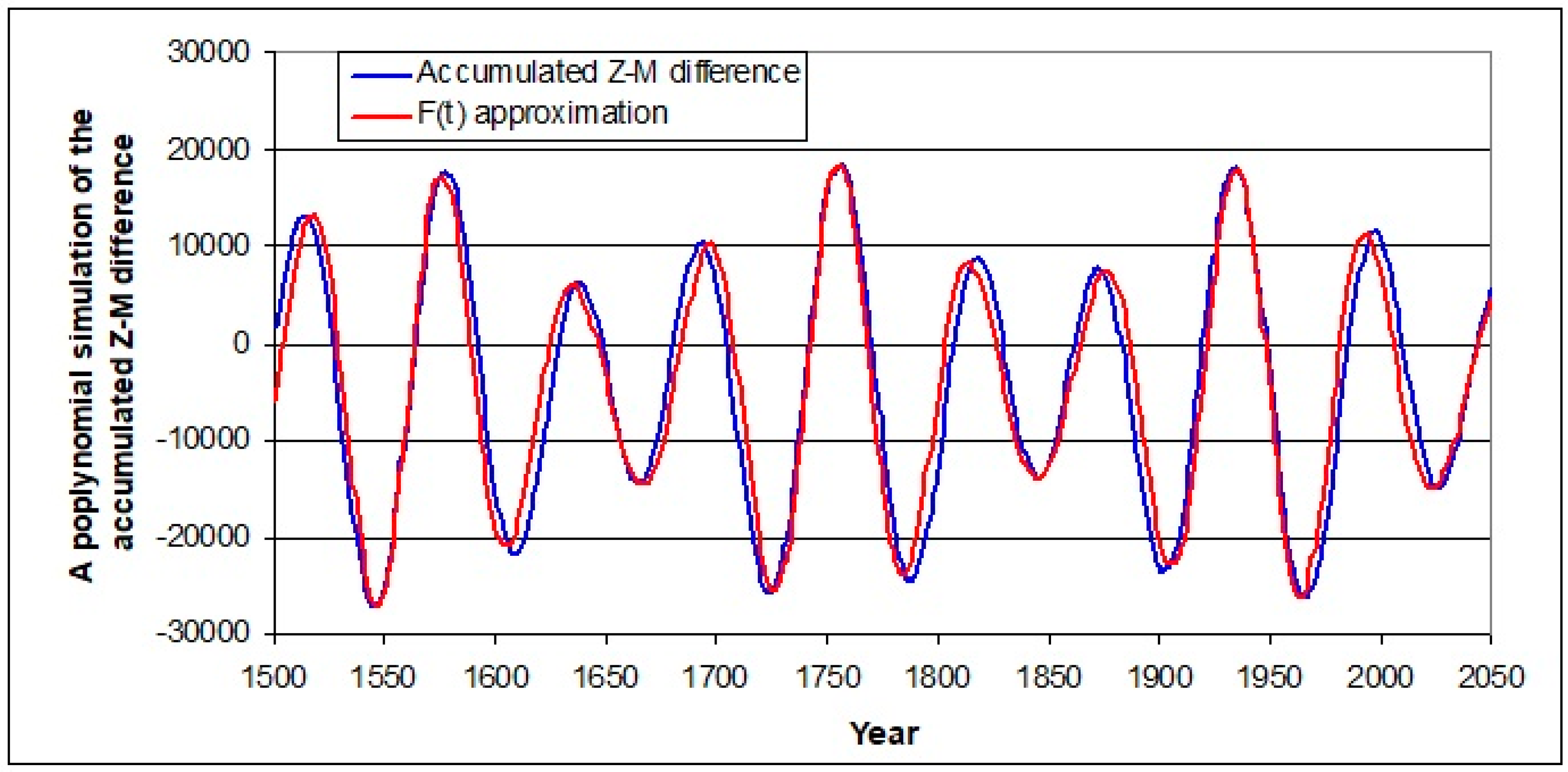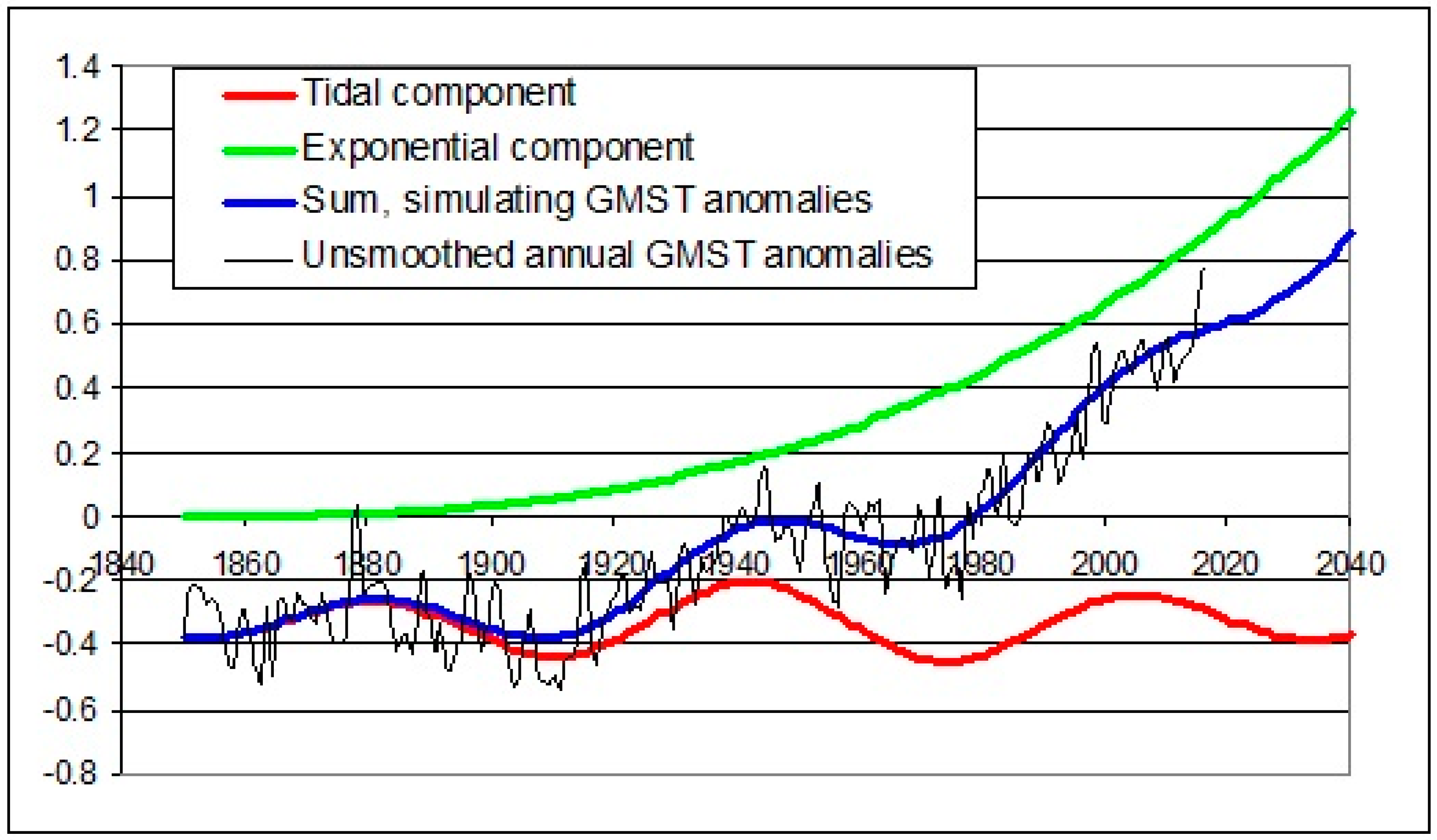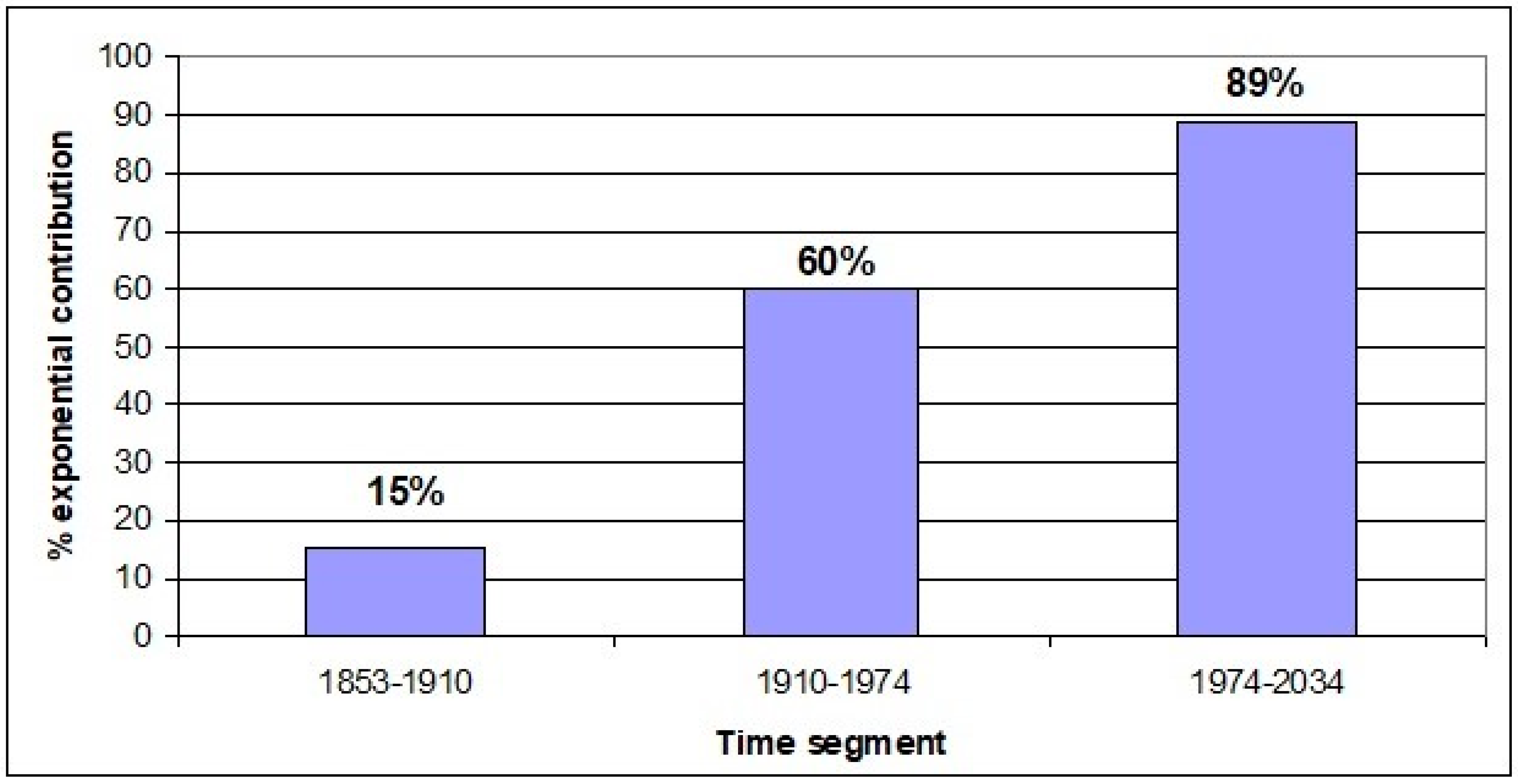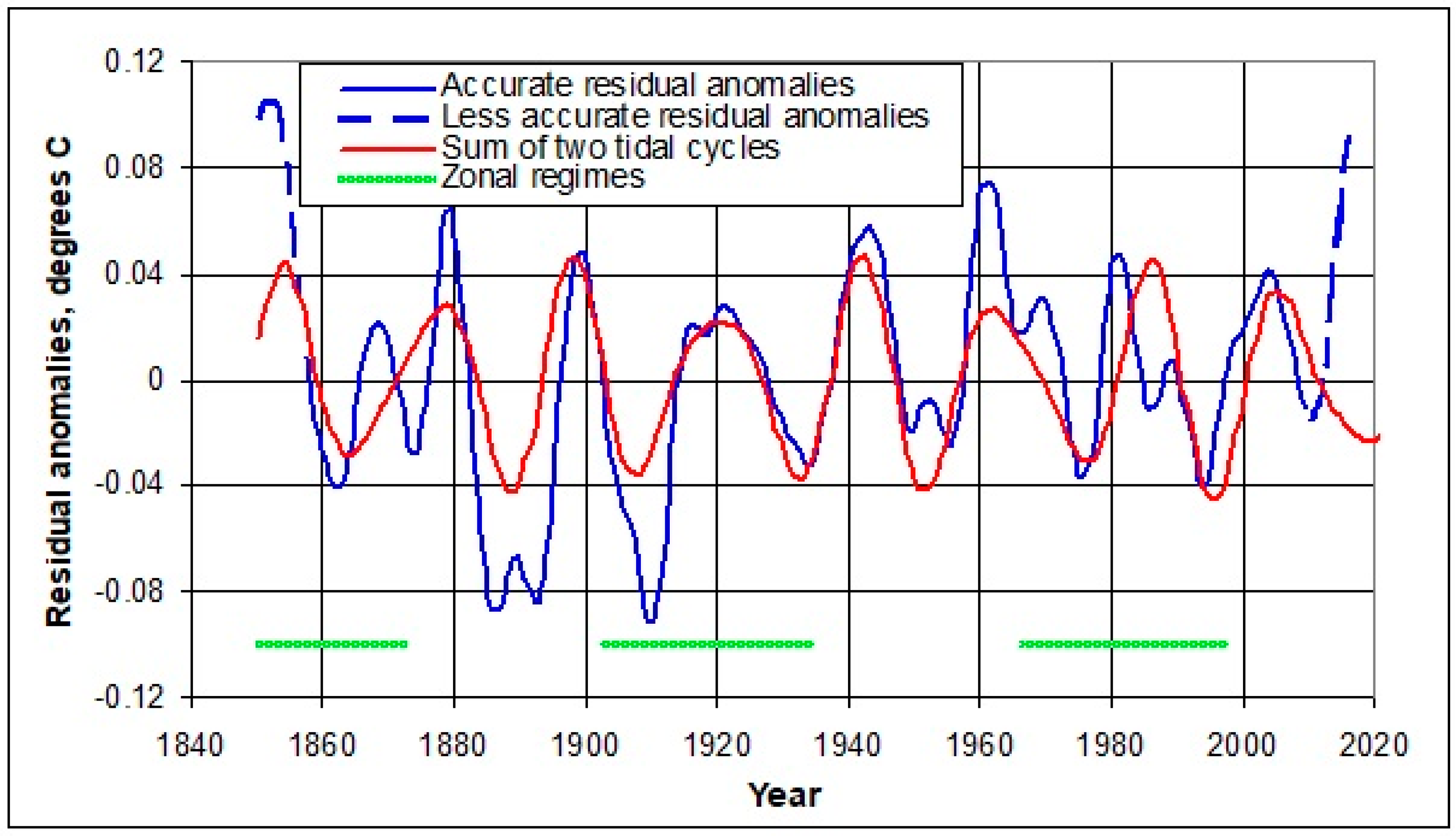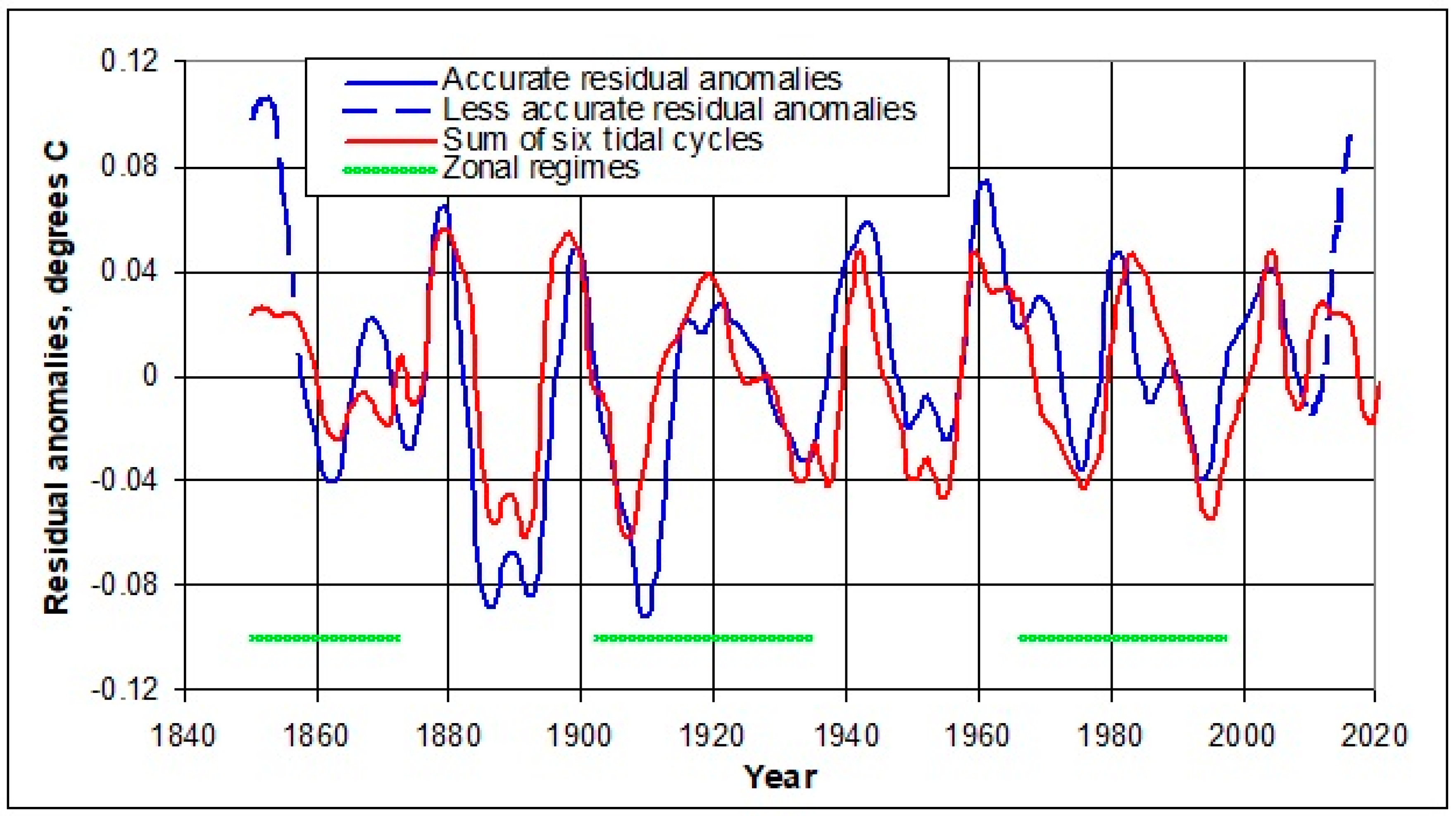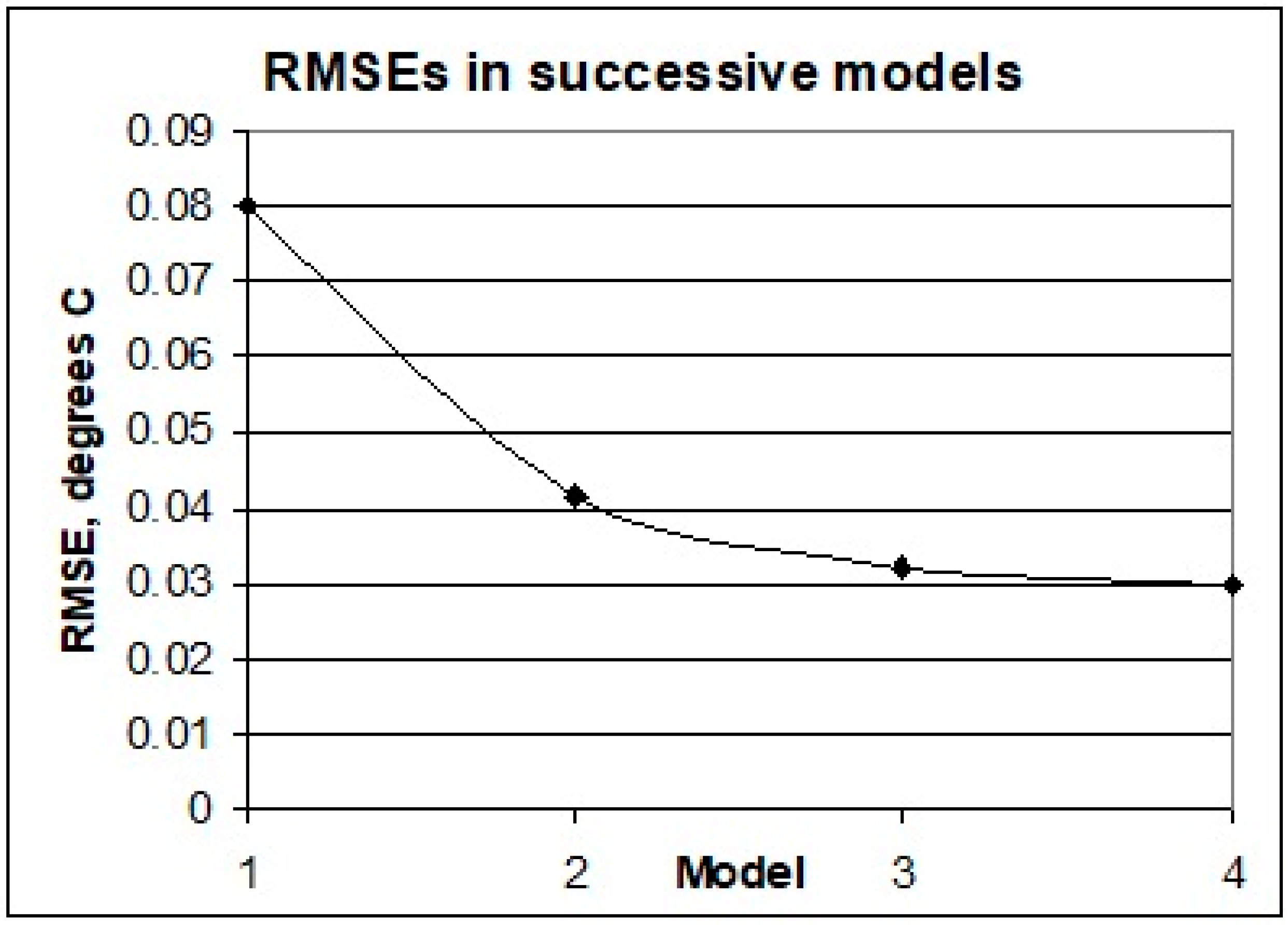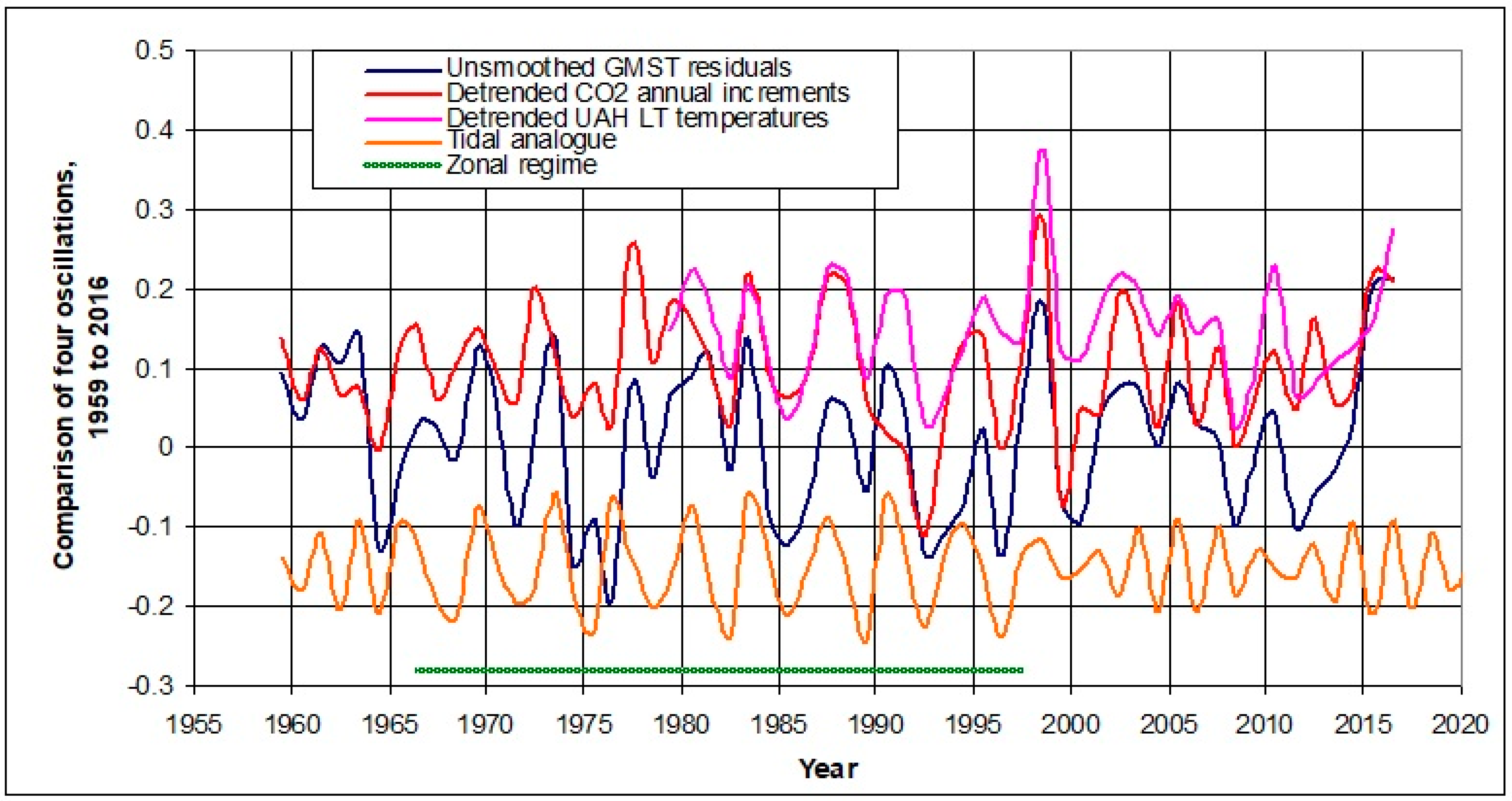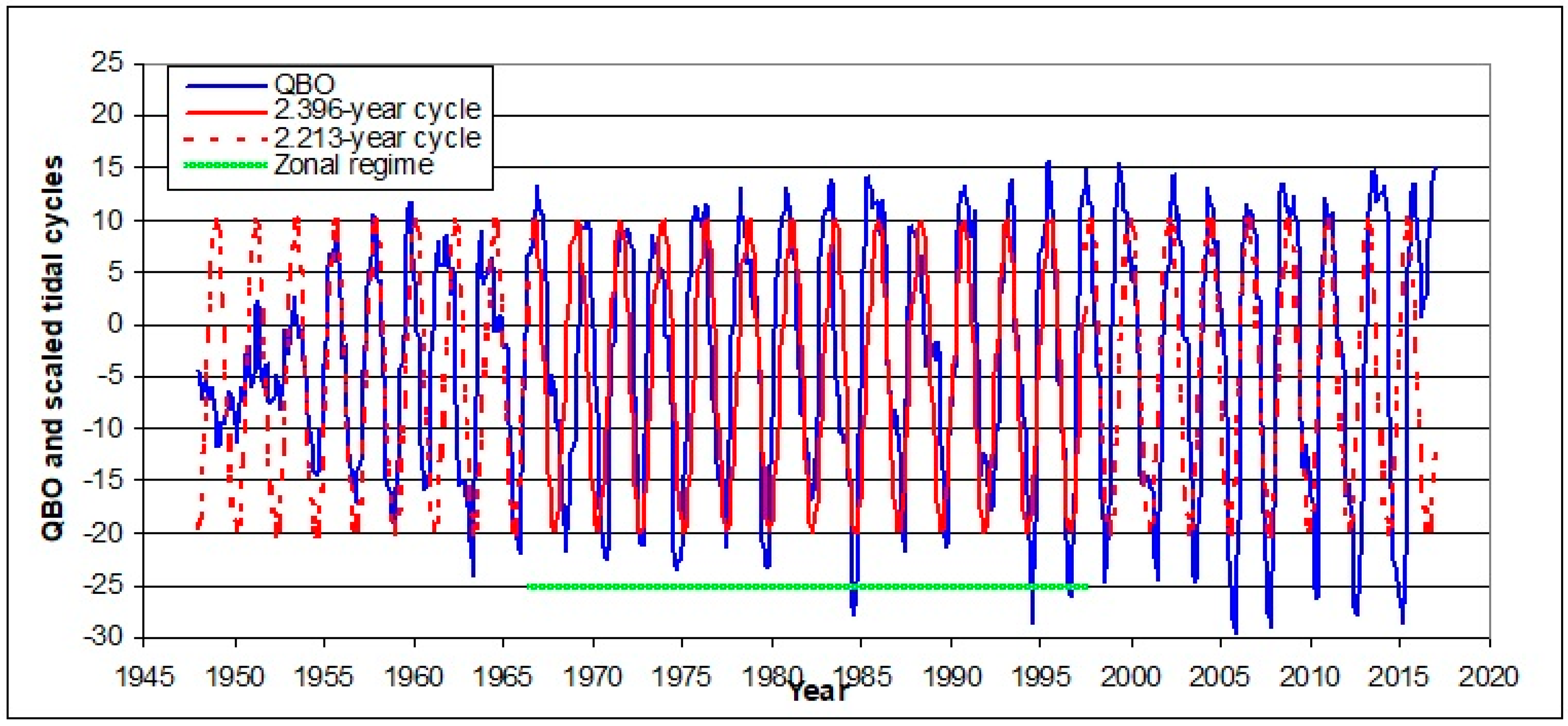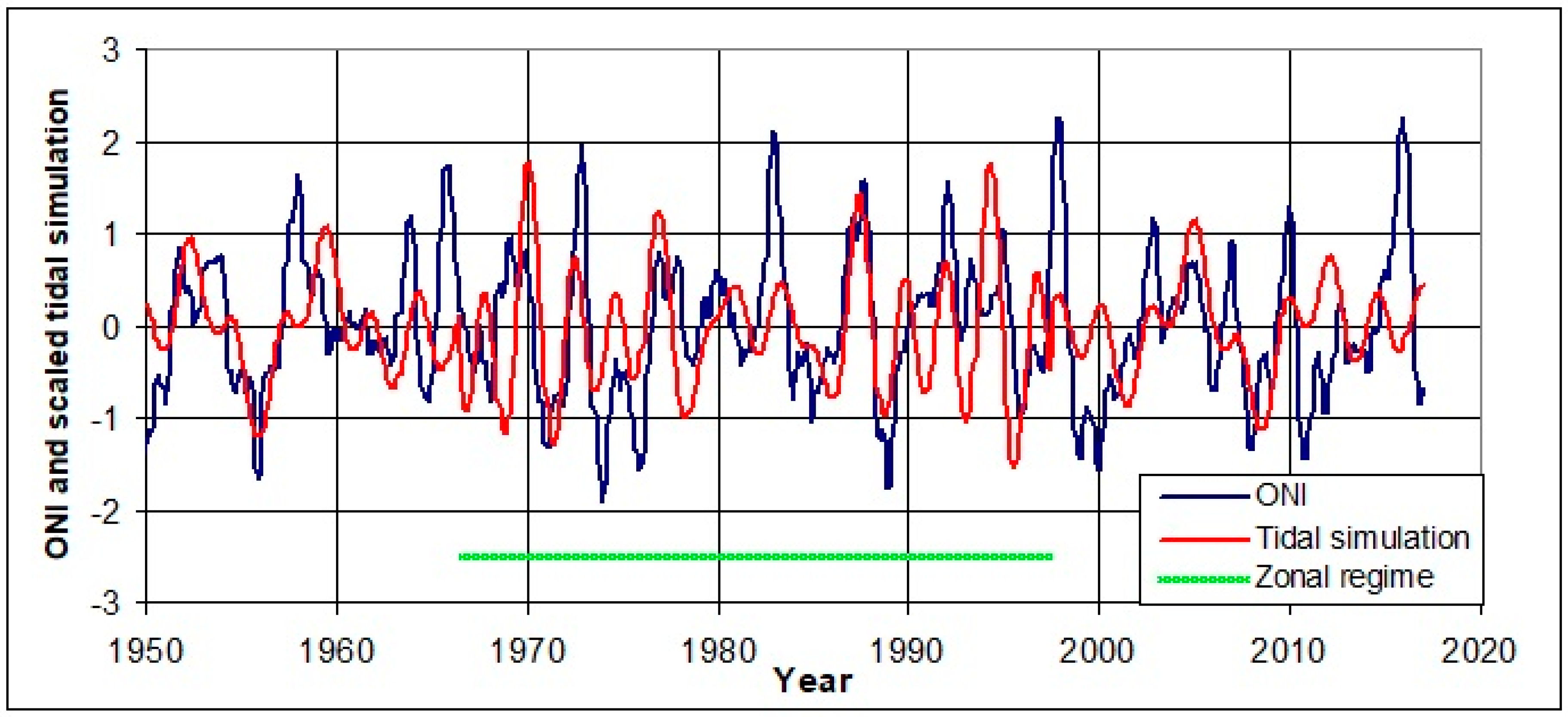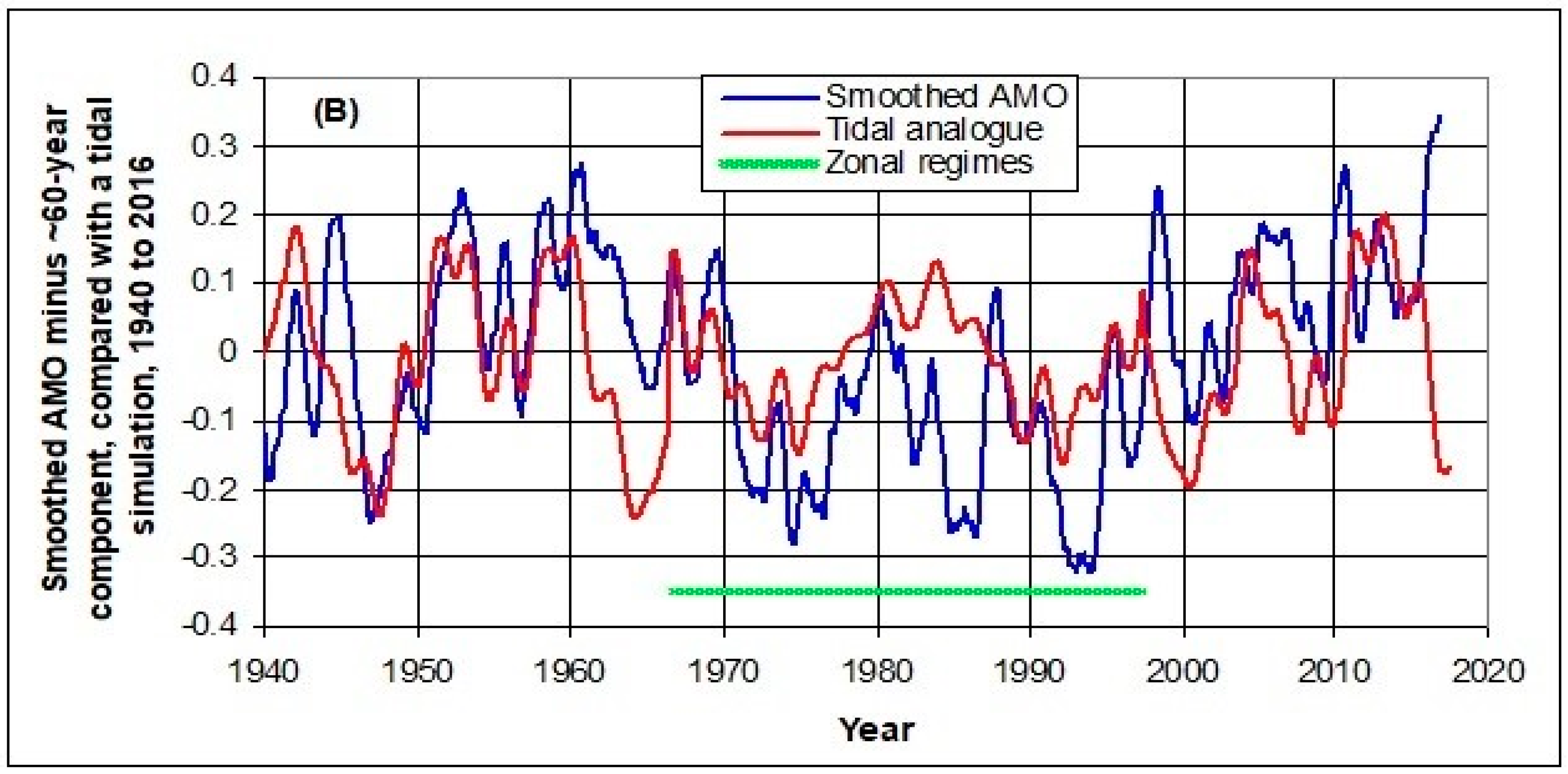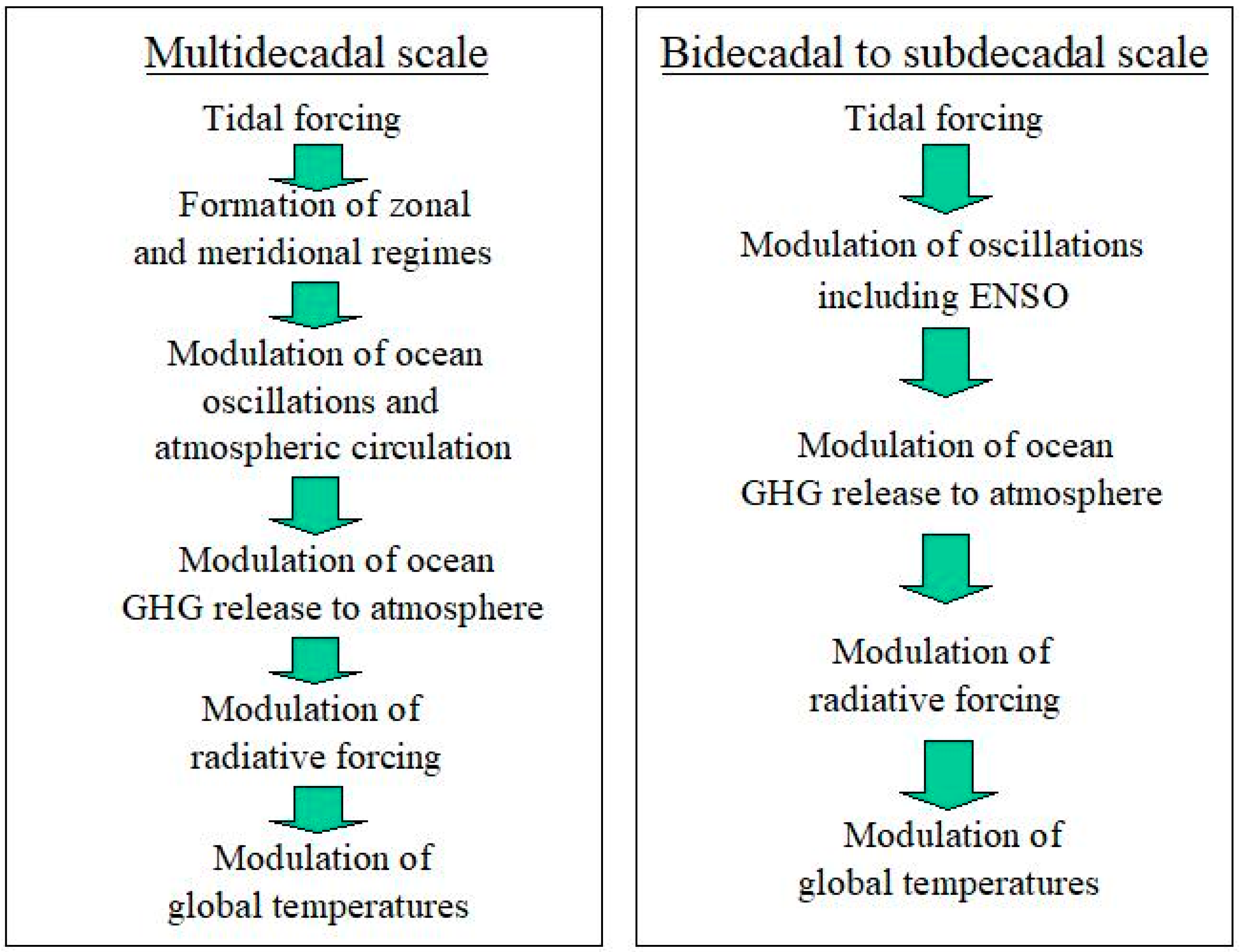3.1. Multidecadal Scale
The three previously derived [
21] multidecadal tidal components, with periods 59.75, 86.81 and 186.0 years, are used for simulations described in this section, and
Table 1 lists their properties relevant to the simulations. The derived reference time t
0 of tidal extrema (maxima or minima) can be used to generate other corresponding times of extrema by adding or subtracting integer multiples of the cycle periods. For example, another maximum for the 86.81-year cycle occurs in 2039.96-86.81, and so on. The 59.75- and 86.795-year events listed in Tables I and II [
21] can be generated by integer-multiple differences of the 59.75- and (now amended) 86.81-year periods from 2039.96. The t
0 parameter represents an effective “time-stamp” for each cyclic component, and the tidal hypothesis stands or falls if this timing is found to be incompatible with patterns in climate or ocean oscillations. This table also lists the “beating amplitudes” described in the
Appendix A.
Following the procedure of Klyashtorin [
4] with the ACI, the difference is accumulated between the cosinusoidal amplitudes of multidecadal zonal and meridional components over time. A simple zonal-minus-meridional (Z-M) curve would serve to indicate a regime according as the curve is above or below a central horizontal axis. However, the Z-M parameter is framed [
4] in terms of the accumulated or integrated difference between zonal and meridional components. This formulation produces a ~60-year oscillation that resembles that seen in detrended global temperatures [
4].
As a test of sensitivity and robustness, the accumulated Z-M differences over time were derived from the tidal hypothesis and compared with the ACI in three different ways. For the 59.75-, 86.81- and 186.0-year tidal components, the respective cosine amplitudes were taken to be proportional to the
Table 1 beating, and the zonal-meridional differences were defined using the amplitudes A of:
- (1)
the 59.75-year zonal cycle minus the meridional 86.81-year cycle only, i.e., A59.75-A86.81;
- (2)
59.75-year cycle minus the sum of the meridional 86.81- and 186.0-year cycles, i.e., A59.75- (A86.81 + A186.0); and
- (3)
the 59.75-year cycle minus the difference between the 86.81- and 186.0-year cycles, i.e., A59.75- (A86.81 − A186.0).
Regressions of the three Z-M differences against ACI data over time gave similar results, the analogs accounting for 83–86% of the variance of the ACI, allowing small lead or lag times. The chief reason for this similarity is that the 186.0-year cycle makes a relatively small contribution. While the theoretically most appropriate analog is currently unclear, the regression result suggests that the subsequent tidal simulation of global temperatures will not differ crucially if a different zonal-meridional difference formulation is chosen among these three.
The scaled accumulated Z-M difference generates a rather irregular ~60-year tidal oscillation. Of the above three tidal analogs, the first formulation, accounting for the greatest fraction (86%) of the ACI variance, is compared with the ACI in
Figure 1. The amplitude at time t (in decimal years) is given in the first instance by:
In
Figure 1, the tidal Z-M calculation begins in 1841.5; the timing of annual data is placed at mid-year. The Z-M difference is then accumulated over the following years and the successive differences scaled to the ACI as
. Although the two parameters are virtually synchronous over this range, 87% of the ACI variance is captured when the ACI lags the tidal Z-M component by one year.
The exogenous tidal mechanism should be essentially unchanged over centuries. The cosine components enable the analog to be projected into the past and future, as shown. The tidal turning points in
Figure 1 occur in the mid-years of 1845, 1872, 1902, 1934, 1966, 1997 and 2026. The rising and falling segments of the two curves define zonal and meridional regimes respectively. The zonal-minus-meridional difference appears to be important, and implies an opposition between forces in the two orthogonal directions.
The accumulated Z-M difference in Equation (1) (unscaled to the ACI) is testable against long-term climate reconstructions and datasets. Over the last century or so, the interval between successive maxima or minima has varied between 62 and 64 years, but the oscillation is slightly irregular, with a mean period of 59.75 years, since it is produced by the 59.75-year cycle in combination with the lower amplitude 86.81-year cycle.
A zero to one-year lag time will be shown to apply to near-surface global and ocean oscillation data at subdecadal to multidecadal periods and relatively small amplitude, and define the zonal or meridional character of the responses by the tidal components. However, an eight-year lag applies to the large-amplitude ~60-year multidecadal oscillation in global temperatures, as deduced in the following. Ocean temperatures will be shown to respond to a combination of these two factors. The accumulated Z-M difference between 1500 and 2100 is shown in
Figure 2, incorporating this eight-year lag to link tidal forcing to correspond to the temperature response. From 1500 to 2100, successive extrema occur around the middle of years of 1521, 1553, 1585, 1617, 1646, 1672, 1701, 1731, 1763, 1795, 1826, 1853, 1880, 1910, 1942, 1974, 2005 and 2034. While the
Figure 1 results are taken to apply to surface phenomena in near-real-time, the eight-year lagged results will be suggested to reflect processes occurring higher in the atmosphere.
Figure 2 shows that the curve of accumulated differences is amplitude-modulated by a long-period oscillation. Analysis shows this latter oscillation to have a maximum at 1944.1 and a period of 191.7 years. This period is attributable to the frequency combination process described earlier, viz.
.
The maximum and period of the oscillation means that a minimum coincides with the 2039.96 reference time for the other two oscillations. Shown in
Figure 2, the ~60-year oscillation over 600 years can be approximated in the form
, where
and
F(t) is a convenient approximation that avoids the annual accumulation process, and allows the multidecadal tidal formulation to be tested against long-term climate data containing the ~60-year oscillation, whether data are annual or monthly. Comparing the accumulated Z-M difference with the F(t) approximation between 1500 and 2050, the mean difference in the times of corresponding extrema is 2.8 years. The F(t) approximation will be applied in
Section 3.3 in relation to the ~60-year oscillation present in measured monthly and reconstructed annual Atlantic Multidecadal Oscillation data.
Tidal forcing parallel and perpendicular to the plane of the moon’s orbit were labeled [
21] as “zonal” and “meridional”, respectively, but the terms are directionally different from their east–west and north–south sense on our planet, because of the tilt of the Earth in relation to the lunar orbit. The rotational axis of the earth is tilted by about 23.5° to the plane of the ecliptic, and the plane of the lunar orbit is tilted a further 5° to the ecliptic, suggesting that meridional tidal forcing should be aligned in a direction 28.5° west of north, perhaps fortuitously resembling the anti-phase pattern in equatorial and North Pacific temperatures (see for example Mantua et al. [
47]).
Figure 1 shows that the ACI has additional decadal-scale elements, and a similar pattern appears [
4] in detrended global temperatures. The decadally smoothed HadCRUT4 annual GMST anomalies [
29] were simulated by a procedure by incorporating the sum of:
- (1)
the ~60-year tidal oscillation, iterating its vertical scaling and displacement, and its lead time with respect to the GMST anomalies’ and
- (2)
an exponential rise in background temperatures, iterating its asymptotic starting year, a multiplier for the exponential, and the exponent itself.
The least-squares errors (LSEs) between the sum of these factors and the GMST anomalies were found for each of the Z-M options examined above for the ACI case. The LSEs were approximately 0.28 °C for the smoothed dataset and 1.6 °C for the unsmoothed set.
In all cases, the Z-M analogs produced matches to the GMST anomalies with the ~60-year tidal oscillation leading the ~60-year surface temperature oscillation by eight years. Thus, recent maxima in the tidal ~60-year oscillation are during the years 1880, 1942 and 2005, although the last is indistinct in the temperature record because of rising background temperatures. Recent minima occurred during 1853, 1910 and 1974. In relation to detrended global temperatures, Klyashtorin [
4] states that the LOD leads by six years, and the ACI leads by four years. The result of the tidal analog leading global temperatures by eight years and the ACI by one year (in
Figure 1) is not consistent with Klyashtorin’s statement, but the general progression is that the tidal Z-M oscillation leads, and the ACI, LOD and detrended global temperatures follow, so that tidal forcing is prior in time and perhaps drives the other processes.
The sum of the exponential and tidal factors accounted for 91–98% of the variance in the smoothed GMST anomalies, the higher number from the Z-M analog chosen for
Figure 1 and
Figure 2 with the unsmoothed set, the three Z-M analogs all account for about 88% of the variance.
Figure 3 shows the iterated result with the Z-M analog for the unsmoothed GMST data: the exponential, the multidecadal tidal ~60-year oscillation with an eight-year lead time, the sum of the two, and the unsmoothed GMST anomalies. The ~60-year oscillation has a mean valley-to-peak height of about 0.2 °C, or a mean cosine amplitude of about 0.1 °C.
Annual data were assigned a mid-year timing, in keeping with the decimal year timing of tidal extrema. The generating factors to determine GMST anomalies at decimal year t from 1850.5 to 2016.5 by the iteration process were:
(1) The tidal ~60-year oscillation for the unsmoothed case, incorporating Equation (1) above:
where a = 5.48 × 10
−6; b = −0.37 °C; and with this Z-M difference accumulated after 1841.5. The series of accumulated tidal values from 1842.5 onward are reassigned such that values at decimal year t become values at t + 8, to co-vary with the eight-year lag in ~60-year global temperature oscillations;
(2) The exponential had the asymptote 1851.5, so that the exponential was assigned a value of zero for both 1850.5 (at the first GMST datum) and 1851.5; the iterated function had the form
(3) These two factors are then summed for each decimal year t.
The same procedure was adopted for the decadally smoothed data from 1850.5 to 2016.5. The results for the asymptote, a, b, c and d, were quite similar: 1851.5, 5.36 × 10−6, -0.37 °C, 5.2 × 10−7 and 2.80, respectively.
The beating Z and M amplitudes in
Table 1, obtained by applying Lorentzian envelopes as described in the
Appendix A, are accumulated as shown in
Figure 2 and have a mean peak to valley accumulated amplitude nearly 40,000 units. The 5.48 or 5.36 × 10
−6 factors are multiples of the accumulated Z-M differences, producing the mean peak to valley ~60-year oscillation temperature range in
Figure 3 of about 0.2 °C.
The exponential removed from 1850 to 2016 HadCRUT4 GMST data is not expected to be greatly affected by small corrections over the recent slowdown (see
Section 2)—noting that the slowdown itself is simulated by the current tidal meridional regime.
The mean valley-to-peak mid-heights for the three ~60-year peaks can be compared to the contribution of the exponential component to GMST anomalies over the same three intervals. If the formulation for the ~60-year oscillation is valid, then it defines an additional exponential or quasi-exponential component with an asymptote in the region of 1850 like that shown in
Figure 3, whatever GMST contributions there may be from other sources affecting radiative forcing from atmospheric greenhouse gases, such as solar irradiance, volcanic eruptions or sulfate aerosols. With the two components shown in
Figure 3, the percent contribution of the exponential component for unsmoothed or decadally smoothed GMST anomalies, averaged over successive ~60-year oscillations (from valley to valley for the tidal component), is shown in
Figure 4.
Extrapolating the exponential to 2050.5 and 2100.5 produces an anomaly for the unsmoothed and smoothed cases of 1.4 and 2.7 °C, respectively. While such an extrapolation should be treated with caution, the projection is of the same order as 2100 “best estimates” for A1T and B2 [
48] and RCP6.0 [
49] greenhouse gas emission scenarios, with temperature change relative to 1980–1999 and 1886–2005, respectively.
Figure 4 implies that, in this formulation, the percent contribution of atmospheric greenhouse gas concentrations to GMST anomalies has risen markedly since 1850, and that the contemporary contribution of GHGs to global temperature rise is almost 90% of the sum of GHG and ~60-year tidal component contributions.
When the accumulated Z-M difference rises, the zonal component dominates; when the difference falls, the meridional component dominates. Temperatures tend to rise in zonal regimes, and exhibit a slowdown in meridional regimes. The implication is that the directional tidal property (zonal or meridional) influences global temperatures through physical effects on oceanic and atmospheric circulation.
On the parameterization in
Figure 3, increased radiative forcing from rising greenhouse gas concentrations in the atmosphere during ~30-year-long zonal regimes is later reversed in the following ~30-year-long meridional regimes. Thus, tidal forcing is hypothesized to modulate the radiative effects of GHGs on global temperature. The slowdown in unsmoothed temperature data after 1998 may reflect the timing of near-real-time (
Figure 1) and lagged (
Figure 2) meridional regimes beginning in 1997 and 2005 respectively and the significant 1998 El Niño. The slowdown is absent in the decadally smoothed HadCRUT4 anomalies, and the simulated anomaly curve in
Figure 3 suggests that no more slowdowns will be seen in the smooth “Sum” curve in future, because of the overriding influence of the exponential radiative forcing component.
The multidecadal pattern similarity indicates an interdependence between core and atmospheric angular momenta, length of day, surface temperature, zonal or meridional circulation regimes and tidal forcing. Since multidecadal tidal components lead global temperatures by eight years—greater than lead times for the other processes mentioned by Klyashtorin [
4] and Dickey et al. [
8]—exogenous tidal forcing from the sun and moon may be a prima facie proximate cause for those processes. If so, then the inevitable question is whether there are feasible physical associations to explain that causality.
There are indicators of interactions between some of these physical components. For example:
- (1)
Oceanic processes can affect angular momenta and LOD. During El Niños, easterly winds along the equatorial Pacific decrease, which increases atmospheric angular momentum. However, the earth’s total angular momentum must stay constant, so the speed of rotation of the solid earth slows down, and LOD increases [
50]. In addition, when evaporation or precipitation occurs over the oceans, mass is redistributed, producing changes in the earth’s atmospheric angular moment [
51].
- (2)
Atmospheric processes can affect angular momenta and LOD. The characteristic time for vertical transport of gases from the surface to the stratosphere is 5–10 years [
52], and water vapor and carbon dioxide are present in atmospheric layers up to the stratosphere. Conceivably, evaporation and migration of these greenhouse gases from oceans to stratosphere occurs during the eight years’ lead time deduced above, during which the LOD and AAM change due to mass re-distribution, and global temperatures increase from the evolved greenhouse gases.
- (3)
The evaporation process may be initiated by directional properties of tidal forcing. For example, a coupled model [
53] simulated a significant increase in global AAM, the increase contributed by an acceleration of zonal mean zonal wind in the tropical-subtropical upper troposphere. Consistent with this, global temperatures increase most in zonal circulation regimes after 1844, 1903 and 1966 (
Figure 3), in response to zonal tidal regimes that lead global mean surface temperatures by eight years.
- (4)
The quasi-biennial oscillation (QBO) modulates the zonal mean wind and the mean meridional circulation, and induces in the tropics large-scale transport of chemical species into the stratosphere [
40]. The relationship of tidal components to the QBO and the connection with tropical processes will be discussed in
Section 3.3.
3.2. Intermediate-Period Scale
This section deals with the residuals obtained after subtracting the ~60-year and exponential components from the decadally smoothed GMST anomalies, using the Z-M choice to simulate the ~60-year oscillation as above. The residual simulation occurs in two stages: first, using the “daughters” (harmonics) of the preceding multidecadal components to simulate residual (bi-) decadal-scale anomalies; and, second, using higher frequency components to simulate the residuals more closely. The daughter components are listed in
Table 2, with periods, frequencies and reference extrema t
0 following their formulation in the
Appendix A.
The decadally smoothed residual anomalies oscillate along a horizontal axis over a range generally less than about 0.1 °C. as displayed in
Figure 5. The smoothed residuals were simulated by regression against the two most prominent “daughters”, the 21.70-year meridional and 14.94-year zonal tidal components; the 18.60-year component made no discernible contribution.
The sum of component cosine functions for the two cycles at time t in decimal years is:
The possibility of a lag time between tidal stimulus and GMST response is evaluated statistically by comparing system data at each time t in decimal years with a formulation for each tidal component cos (2π[t tlag t0]/P). For example, testing a three-month lag time for GMST (or residual) data points at decimal years t in relation to the 14.94-year tidal cycle means testing the GMST data against the cosine relationship
The best-fit residual anomaly lag time was 0.45 years after omitting from the regression the first and final seven years of the residuals to avoid end effects in the smoothing [
54] that may have been responsible for the high anomalies at the beginning and end of the series. The small corrections proposed to HadCRUT4 data over the last slowdown (
Section 2) fall shortly before or during the latter time with end effects, so that any late-year biases in the HadCRUT4 data should have little effect on these results.
On multiple linear regression, the cosine amplitude multipliers for the 21.70- and 14.94-year harmonic components were −0.034 °C and −0.013 °C; the probability t statistics were −10.6 and −3.8, and the p statistics were 5.5 × 10−2 and 1.3 × 10−4 respectively; the multiple R was 0.68. The negative multipliers and t statistics imply that tidal maxima from the two components were accompanied by lower GMSTs, consistent with tidal forcing promoting ocean upwelling. The 18.60-year harmonic component made no significant contribution (p = 0.58).
The residual curve shows lower temperatures than the tidal curve for minima around 1890, 1910 and the late 20th century. Volcanic eruptions in 1883 (Krakatau), 1902 (Santa Maria and Mt. Pelée), 1912 (Novarupta) and 1982 (El Chichón) may account for some of the difference by reduction in solar insolation; however, an effect from the 1991 eruption of Mount Pinatubo is not evident.
Figure 5 indicates that higher frequency components are needed to improve agreement with these anomalies.
Volcanic eruptions eject dust particles and gases. Some of these gases, such as water vapor and carbon dioxide, are greenhouse gases that cause warming, while the emitted particulates block the sun and cause cooling. The cooling effect is usually most noticeable in temperature curves like the above, because the effect is relatively large and occurs over a short period. Ejected greenhouse gases disperse in the atmosphere and their warming effect is longer-lasting and can be less noticeable. The cooling effect from volcanic particulates is the feature most closely evaluated in climate studies. Greenhouse gas contributions from volcanoes are almost negligible compared to those from human sources.
The second stage in simulating the decadally smoothed anomalies is to apply more intermediate-period components to address the subdecadal “fine structure”; the added tidal components are listed in
Table 3. The original formulation [
21] found an irregular meridional component with a mean period of 5.775 years, later amended to 5.778 as described in the
Appendix A. The additional components are identified here as frequency combinations. Thus, frequencies corresponding to components with periods 8.848 and 47.96 years are generated from ν
5 + ν
6 and ν
5 − ν
6, therefore equivalently from ν
1 and ν
2. Since the generating components had reference times t
0 at 2039.96, the new components are assumed to have the same t
0. The period results were slightly corrected to means of 8.850 and 47.92 years by finding intervals from 2039.96 with frequent occurrences of close syzygy. In the case of the slightly irregular 8.850-year component, Fourmilab shows that every third interval occurs near alternately close new and moon events, but these close syzygy events are displaced from the 2039.96 reference time t
0 by half a cycle. Over many three-fold cycle intervals, the mean cycle period is 8.850 years. Despite the half-cycle displacements, when climate oscillations are compared with functions cos (2π[t + t
lag − 2039.96]/P), the same t
lag is found to apply to the 8.850-year component. It was unexpected to find the period (8.850 years) of the moon’s apsidal precession numerically generated by a combination of ν
5 and ν
6, and equivalently of ν
1 and ν
2, components. Other new components generated are 3.495- and 16.69-year components from ν
4 and ν
8, so ultimately from ν
1, ν
2 and ν
4. Often, 3.5-, 5.8-, or ~17-year ocean cycles have been reported (e.g., [
55,
56,
57]). As may be expected, higher frequency tidal components tend to show more significance in monthly than in annual datasets.
With these added components, the curve for “most reliable residual anomalies” can be empirically simulated more closely than in
Figure 5.
Figure 6 shows one result, assigning regime-dependent amplitudes according to
Table 4. Discontinuities in
Figure 6 occur as regimes change. Reaching statistical significance (
p ≤ 0.05) in component correlations is affected by the small sample size [N(zonal) = 80; N(meridional) = 75]. All six components reach statistical significance in at least one regime type except the 5.778-year component, although it is the 8.850- and 5.778-year components that simulate the subdecadal features. The 18.60-year component had a less significant contribution to the simulation than the other six components, and has been omitted from
Table 4 and from the simulation. The best-fit lag time for the residuals is 0.40 years.
As mentioned above, the sum of the tidal ~60-year cycle and the exponential rise (
Figure 3) accounts for 98% of the variance in the decadally-smoothed HadCRUT4 anomalies. For the residual decadal-scale anomaly in
Figure 5, the accompanying two-component tidal curve captures 41% of the remaining variance, while the six-component and regime-dependent approach associated with
Figure 6 and
Table 4 account for 53.5%. The results suggest that tidal forcing modulates the approximately bidecadal variation in GMST anomalies.
The improved agreement shown in
Figure 6 is derived empirically. However, at face value these results are consistent with the earlier rise-and-slowdown multidecadal results, that global mean surface temperatures are regime-modulated. Since global temperatures are responsive to ocean surface temperatures, this then suggests that including regime changes may improve the way that (for example) ocean oscillations could be characterized.
Table 5 displays values of correlation coefficient (R) and root mean square error (RMSE) as progressively more components have been added to simulate HadCRUT4 decadally smoothed GMST anomalies. Model 1, a single exponential, was not reported earlier in this text, but is included as a baseline reference. The least-squares exponential has the form:
Model 2 consists of the exponential plus the tidal ~60-year oscillation. For the smoothed dataset, Model 3 consists of Model 2 components plus the 21.70- and 14.94-year tidal cycles. For the smoothed dataset, Model 4 consists of Model 2 components plus six regime-dependent tidal cycles.
Figure 7 shows the improvement in simulating these anomalies, as measured by RMSE values.
The remaining unassigned errors in
Figure 6 may be attributable to factors such as the averaging of unsmoothed contributions and an absence of components operating on the decadal scale. Tidal components will be compared with unsmoothed data in the rest of this paper.
To summarize the hypothesis at this stage, decadally smoothed global mean surface temperatures have the following contributing sources:
- (1)
an exponential component that resembles models for the effects of greenhouse gas concentrations;
- (2)
a ~60-year oscillation caused by an eight-year lagged response to exogenous multidecadal tidal forcing, possibly through the delayed temperature response from vertical transport to the atmosphere of greenhouse gases during zonal regimes;
- (3)
intermediate-period temperature variability caused by decadal-scale tidal forcing, with different contributions during zonal and meridional regimes, and with temperature response lagging the tidal stimuli by 0.4 or 0.45 years (about five months); and
- (4)
other contributions, not quantified in this paper, that may include those from episodic volcanic emissions and man-made emissions of pollutant aerosols.
